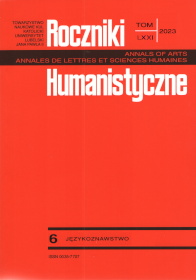Chwasty w polskiej kulturze ludowej
Weeds in Polish Folk Culture
Author(s): Katarzyna ProrokSubject(s): Anthropology, Social Sciences, Language and Literature Studies, Customs / Folklore, Theoretical Linguistics, Semantics
Published by: Towarzystwo Naukowe KUL & Katolicki Uniwersytet Lubelski Jana Pawła II
Keywords: Polish folk culture; linguistic worldview; definition; weeds
Summary/Abstract: The aim of this article is to reconstruct the linguocultural worldview of weeds in the Polish folk tradition. The analysis of the rich source material collected in the file of the Dictionary of Folk Stereotypes and Symbols shows that the image of weeds is inhomogeneous. On the one hand, as wild plants that destroy crops, they functioned as symbols of uselessness and harmfulness, they were believed to come from the devil, and therefore numerous methods were used to eliminate them. On the other hand, they also had some practical, ritual, magical and healing uses, e.g. cornflower, poppy, cockle corn and bindweed were used as ornaments, and wreaths and bouquets were made of them; goosefoot, nettle and young thistle leaves were famine food; hepatitis was treated with couch grass tea, and prickly thistle and stinging nettles were put on the threshold as protection from witches. This multitude of functions is reflected in the categorisation of the plants – one plant could be considered by a farmer as a harmful weed and at the same time as a flower used for decoration or a herb when used in folk medicine or magic.
Journal: Roczniki Humanistyczne
- Issue Year: 71/2023
- Issue No: 6
- Page Range: 279-293
- Page Count: 15
- Language: Polish

